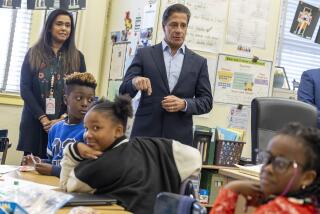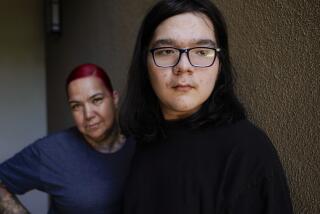Time for a change
TOO MANY OF the kids who’ll be sitting down to Thanksgiving dinner Thursday weren’t sitting in a classroom chair Tuesday. Student absenteeism commonly doubles during the first half of Thanksgiving week. For that matter, teacher absenteeism jumps as well.
The simple tradition of gathering with relatives isn’t so simple anymore. A generation or two ago, extended family lived within driving distance; now, a more scattered and international populace descends on airports to fly to distant destinations — and why bother enduring the hassle and cost of air travel for just a couple of days’ visit?
Likewise, winter recess has changed for many Southern California school districts. The Christmas holiday is traditionally the time when Latino immigrants reunite with family in Mexico or Guatemala. Because the trip can be long and expensive, and because there is a cultural tradition of staying on to celebrate the Festival of the Three Kings on Jan. 6, these children generally miss at least one week of school, which starts again at most local school districts Jan. 2.
Schools lose state funding when students go AWOL, and they shell out extra for substitutes when teachers do the same. Valuable instructional time is lost. What’s to be done if so many families will not conform to the school calendar?
Easy. Change the school calendar.
Except for year-round schedules, usually made necessary by overcrowding, schools have been following the same calendars, with little variation, for more than a century. But students and families aren’t the same as they were in the 1800s. There are more two-income households, more geographically scattered families and more immigrants. Depending on their demographics and other needs, school districts should experiment with innovative schedules to boost attendance.
Public schools in Los Angeles and in Santa Ana, where a majority of students are Latino, are already doing that, with a three-week winter break ending after the Feast of the Three Kings. In Los Angeles, absenteeism just before and after the break in schools able to offer the extended vacation is only 2 percentage points above normal.
Yet traditionalists criticize a schedule change, arguing that it caters to the whims of irresponsible parents. This argument is out of sync with the U.S. school calendar’s true tradition, which is to work around family needs.
The current three-month (or so) summer vacation is a relic of the days when the nation was primarily agricultural and children were obliged to work on family farms during the growing season. In pioneer days, schools in the rural Snowbelt closed for the winter after the first major snowstorm because travel to school was unsafe. Similarly, public schools in the New York area with large Jewish populations have historically closed for the Jewish High Holy Days in autumn.
The Capistrano Unified School District experimented with closing schools for the entire Thanksgiving week after finding that student and teacher absenteeism was going through the roof. It proved immensely popular and successful, but this year the district only gave today off.
The challenge is more difficult for the crowded Los Angeles district, with so many schools still on year-round, multitrack schedules. But as the district continues its building spree, more schools are moving to traditional calendars — giving them the freedom to be untraditional in ways better suited for 21st century students.
More to Read
Start your day right
Sign up for Essential California for news, features and recommendations from the L.A. Times and beyond in your inbox six days a week.
You may occasionally receive promotional content from the Los Angeles Times.






